
“We don’t rise to the level of our expectations, we fall to the level of our training.” - Archilochos (6th Century BCE Greek Poet)
Much in life is about our training and preparation. This is especially true with running. Whether it’s a shorter distance or a marathon, how well you train has a huge impact on how well you run a race.
When it comes to running, there is a lot to digest on the topic of training. There is both a lot of science as well as a lot of long-held beliefs, traditions and even folklore. As a new or even moderately experienced runner, one of the most important yet confusing areas to navigate are training plans.
Run training plans have been around a long time, and they remain a popular topic online and in fitness magazines. There are hundreds of running programs and training plans out there.
Whether it’s your first 5k or your next marathon, these plans are intended to help you prepare. Some are more geared towards just completing the race distance, while others focus on helping you improve. There are plans for pure beginners and even plans for elite athletes.
If you have no idea how or what to train, then these training plans can be a huge help. I followed a run-walk plan to complete a 5k and used a plan with a coach when I did my first marathon.
In this post, I want to share my take on run training, training plans and my experience using an adaptive run training system called TrainAsOne. I’ve used TrainAsOne to successfully achieve Personal Best’s (PB) at races ranging from a 5k to two Half Marathon’s, and I’m currently following this plan to prepare for my second marathon.
To give you a bit of background, I’m a 34-year old male. I consider myself a tracking, data guy who runs. I’ve been running consistently for about a year and half.
What is a Run Training Plan?
At its most basic, a run training plan prepares you mentally and physically for a race. There are various challenges that come with running a long distance at a certain speed, and training helps you to get ready for them.
Before we go into the technical elements, it’s key to recall the two most important aspects to consider when building a training program:
- Avoid injuries
- Run targeted workouts that provide the most benefit towards your goal
I’ll admit that I’ve broken the golden rule of training about not getting injured. I got a bit of ambition, ran too much, didn’t properly increase my weekly volume, didn’t get enough rest, didn’t do my mobility exercises, etc. and I got hurt.
Realizing how important avoiding injury means listening to your body, and when you don’t feel right, you need to limit your training or get some rest.
Like most newbie runners, I started training by just running, and I definitely improved. But eventually with plenty of reading about running and a coach, I realized the importance of having a plan.
Training for a race boils down to stressing the body, then recovery to “bake in” your gains. You stress the body, then with rest, good nutrition and sleep, you improve. This is called the theory of supercompensation, and a training cycle looks like this:
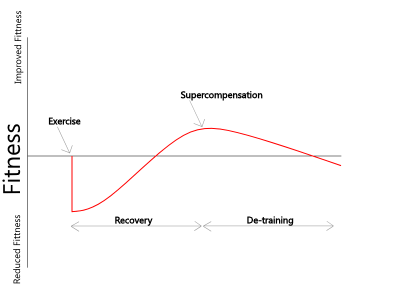
Exercise actually weakens you. It’s through rest and recovery that your body compensates, and you gain fitness. This is the up-and-down cycle of stress-recover-improve.
In view of this cycle, running plans should mix different “stressors” (i.e. workouts) and enough rest over different periods in order to get you ready. For example, on the workouts side, you use long runs to build up your speed, long runs to build up your endurance, and targeted runs to test a paced speed over a set distance. In-between you rest and recover.
Basic Elements of a Run Training Plan
The purpose of a run training plan is to help you prepare and excel at a race.
A run training plan is a combination of different run workout types and rest used to stimulate (or stress) the body in different ways and provide enough recovery to improve. These stresses build up different physiological capacities needed to run at certain distance or speed. Proper rest, sleep, nutrition, etc. provide time for you to repair.
In Running Workout Types: Knowing and Manipulating These Runs to Optimize Your Training, we looked at the four core workouts types for training:
- Interval Training
- Long Runs
- Tempo Runs
- Races, Time Trials and Assessments
Along with a few other minor run types like Hills, these core workouts can be tweaked with other variables like speed, terrain, volume, reps, and others to help stimulate the target response.
In the Science of Running, which I highly recommend and reviewed here, Steve Magness goes into detail on how each of these elements can be leveraged to optimize peak performance.
Building a good running plan isn’t easy though, especially when you consider first how many variables there and second how to adapt them on an individual level. What type of run should I do? How long? How far? What speed? How many reps? How many days break should I take after?
Key Aspects to Consider About Run Training Plans
There is no consensus on the best training plan, and so training plans will continue differ.
In spite of that, personally, I think there there are a few key aspects to think about when comes to choosing or adapting your own run training plan:
- length (how long is the plan for?),
- initial fitness level (is this a plan for beginners or advanced runners?),
- initial mileage (how many miles or kms are you expected to start at?),
- ramp up, (how long is the build up mileage and long runs?), rest (are you getting enough rest to avoid overtraining and injury?),
- frequency (how often are you running per week? how often will there be long, easy and speed workouts?),
- longest run (what is the longest run per week in the plan?).
These are a few questions you should consider when looking at a plan. If you are a beginner, you’ll want to be more conservative and look for a plan that provides enough rest and recovery as well as enough time to build your running foundations.
Problem with Traditional Running Plans
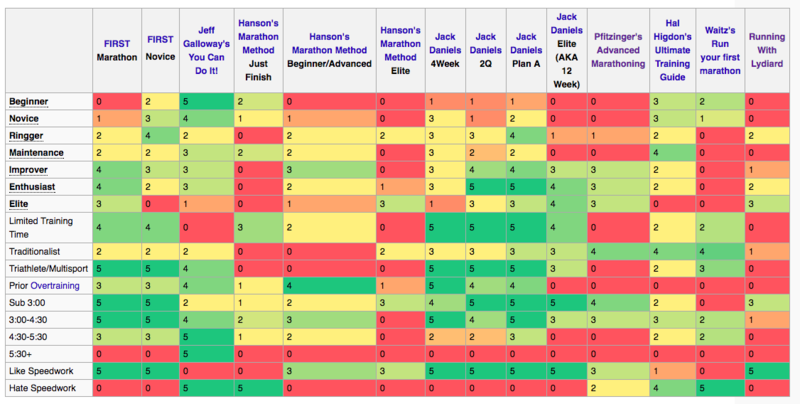
There is a good degree of disagreement about the best running plan and even the core tenants. This disagreement partially stems from the reality that different people respond differently to different different plan and different stressors. Some might find a plan too easy, another might be overly taxed by it and become “overtrained”, and a few might find it just right and get fitter.
I’ve read several books on running, including a few plans. The most well-known running plans are: FIRST’s Run Less, Run Faster, Galloway’s Run-Walk plans, Hanson’s Marathon Method, Hal Higdon’s Plan, and Jack Daniels’ Running Formula.
A full comparison of training plans is outside the scope of this post. Checkout Fellrnr’s Comparison of Marathon Training Plans for a good starting point.
The important thing to remember about most of these plans is that they were developed by coaches and athletes before smart phones, wearables and other common sport trackers that are commonly used today. The basics of run training are present in all of these plans, like mixing workout types, but the effectiveness of each is built on “success stories” rather than pure science. This makes it hard to be sure which is best.
The reality is that any plan that pushes you enough but avoids injury will make you faster and fitter. So, if you aren’t sure, pick one that “feels” right and follow as best you can.
The main problem that I have with the available run training plans out there is that they are static. They provide a set schedule and a list of runs to do. They don’t provide on-going feedback or specific targets. They don’t even use the tracking data I have from each run I do.
These static plans, in principle, are a starting point to training. But they don’t adapt to you. Instead, they expect you to adapt to the plan. This can can lead to injury or ineffective training.
Having a coach can help since she can provide adjustments to your plan and advice as you develop. But even a coach can’t analyze and adjust training plans at the level needed to be most effective.
Most runners and athletes today use a range of devices to quantify and track their activities. Wearables, phones and watches make it possible to know our speed, pace, heart rate, elevation change and many other factors.
These data points can be extremely powerful indicators of your training and fitness level. Unfortunately human coaches can’t possible process all of details and numbers in your training logs either. At best, coaches can focus on a couple key metrics in each workout and each training period and go from there.
Only computers can learn and deal with the level of information you get from tracking all your runs. This integration of computers to understand each and every run as well as to adapt to our fitness is where technology is changing how best to train. This is where an adaptive training system like TrainAsOne is truly changing the game of training.
Finding My Next Step Post-Marathon
I was fortunate that I had both a coach and an adaptive plan during my first marathon training. We followed a plan with different stages and used varying workouts to stress the body during each stage. With periodic check-in or calibration runs, we could know how well the training was working for me.
As a beginner, I definitely improved. But I felt like it was too easy at times. The issue was that my coach’s chief concern was injury. He was very careful to avoid overstressing the body, so we tended to keep workouts safely within those limits. This kept me from getting injury, but I don’t think it pushed me as effectively as possible. The buildup was a too slow too.
Following a nice rest after my first marathon, I looked at various running plans to continue my training. They all contained elements from first training plan (different workout types, a buildup phase, a tapering, etc.), but to be honest, my concern was finding my target numbers.
A few plans offered calculators to determine my pacing. But it was going to take work to know exactly what paces to run and how hard. The plans provided the framework but didn’t provide any specific targets.
I also wasn’t entirely sure what race I’d do next, but I wanted to start training all the same. My first step was settling on a mid-term goal of training and running a better 5k. Luckily, I discovered TrainAsOne, which was the running plan I decided to try.
What is TrainAsOne?
TrainAsOne is an adaptive training system that tracks and analyzes your runs and proposes the best workouts to avoid injury and maximize your gains.
To quote: “TrainAsONE is an intelligent training system based on proven scientific research.”
The system uses all of the metrics from your runs like location, pace, heart rate, elevation, etc. This data is used to understand past and current workouts. It then takes that data along with your specific goals, and, with machine learning and algorithms TrainAsOne generates a personalized training program. These plans focus on minimizing injury while improving gains as efficiently as possible.
In this post, I won’t go into the logic and numbers TrainAsOne uses to understand your running, build your running plan and adjust periodically.
Suffice as to say, TrainAsOne uses several clear research-backed principles about run training to understand your training and propose targeted workouts that best prepares you.
Let’s look at how I’ve been using the system.
First Steps: My Own Smart Coach with TrainAsOne
After signing up and joining, TrainAsOne pulled in my full history of past runs, examined these workouts and set my initial baseline numbers. After setting my next goal (5k) and my commitment (4-5 runs per week), it started to generate an on-going plan of weekly workouts. These workouts not only included the type of workout but also the target distance, pacing, intervals and even target heart rate if I would be running on hills or uneven terrain.
The first step in using TrainAsOne included two assessments: 6-min assessment and a 3.2km assessment. These assessments appear regularly as you use the system, and I assume it provides a validation on the other metrics it draws from other workout types. For example, these assessments could be used to determine your VO2 Max, Lactate Threshold and Running Economy.
Here is what my first few weeks with TrainAsOne looked like:
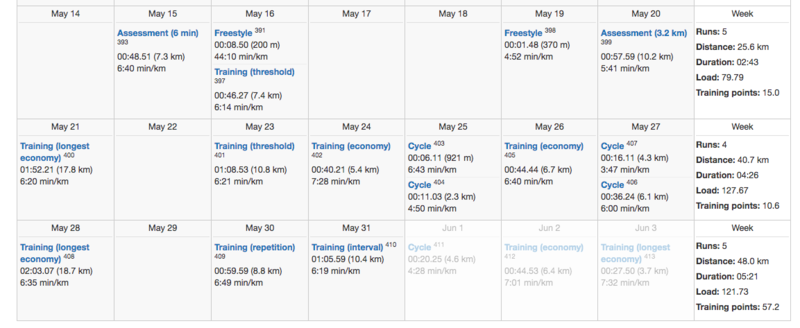
Initially I was a concerned with how easy the workouts seemed and the pace seemed slow. By as I continued through the assessment runs and a few weeks of training, the system got better and better at giving me quality workouts.
By mostly following the generated workouts, I quickly improved. I became capable of running better repetitions and maintaining my pace through more reps. During this period I noticed an improvement in my speed at shorter distances too.
Here is the sample workouts I did in the subsequent three weeks:
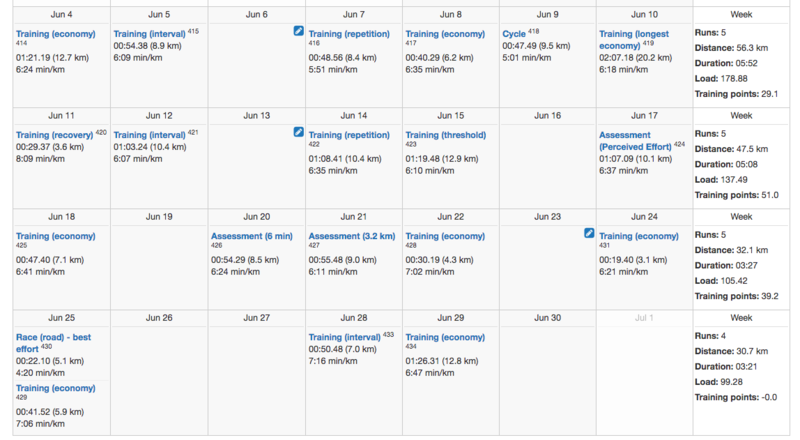
What you’ll notice is that the workouts are clearly a mix of workout types. It’s more difficult to see, but the workouts are also adapting to my changing physiology and environment too.
As I improved, the workouts challenged me to increase my pace (repetitions) or do a longer distance I’d mastered at a short distance (threshold).
Similarly as temperature and humidity increased where I was, the workouts were adjusted to avoid over stressing my body at a pace that I could do in cooler conditions. These kinds of minor adjustments helped tailor the workouts and expectations.
At the end of June, during a few days in San Francisco, I participated in a 5k morning race. Through a combination of good training and great running conditions, I ran a personal best time of 21:17.
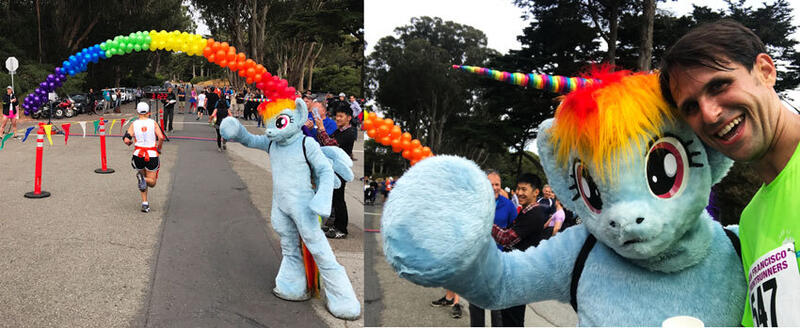
This race was my first personal validation using TrainAsOne.
Lessons Learned Using TrainAsOne as My Adaptive Training System:
Since my PB in the 5k, I’ve used TrainAsOne to provide target training workouts for a 10k and two half marathon races. In every single situation, I’ve improved without getting injured. A few weeks ago, I ran my first half marathon in under 1:45.
Obviously a lot of improvement in running comes from running, so I’d be remise to claim that “TrainAsOne did it all.” In fact, personal consistency was a huge help as well as my ability to stay motivated and follow through on the training.
There are a lot of lessons I can learned from this experiment in run training with TrainAsOne. Here are a few that stand out:

Consistency and Quality: Since using TrainAsOne for over 6 months, it became clear that my previous training, while adequate, wasn’t always on target or high quality. There were periods of junk mileage, runs where I ran too hard, and others where I had no goal at all. Since changing to this system, I’ve become consistent in my running and my workouts are of good quality. The benefit of having an adaptive coach is that I do workouts that feel about right for my level and needs. I’m not burned out but I’m pushed when I’m ready.
Train With Intentionality: Mentally I also realized that run training isn’t necessary about every single run at either end of the spectrum. Runs aren’t either at maximum or at “fun run” speed. Instead, each and every run was about intentionality: having a goal for that run and then running it as best you can towards that workout’s objective. TrainAsOne helps me get better at realizing what each workout is for and embracing that I should run it at that intended target.
Trust Your Body: I’ve been mostly fortunate to avoid sickness, over stress or injuries. That means I can go out and kick ass on my training runs. Still there are times when I’m off for various reasons. I’ll not sleep right, drink too much or some other factor. When I wake up my Heart Rate Variability will be down and I’ll feel off. On these days, I trust my body and either go easy on the run or take the day off. The problem with static run plans is that they can’t adjust to this change. By contrast, TrainAsOne simply sees you missed a workout and proposes the best workout for the next best slot.
Trust the Process: Improving as a runner is about consistency, avoiding injury and not going into “detraining” mode. Detraining is when you stop running and lose your gains. With training plans, you are following a process where you stress your body and gain improvements. It’s an up and down journey. Fortunately you can notice these changes in your numbers, and an adaptive coach like TrainAsOne can propose challenges to get you to your next stage. Similarly even when complete a race and your “plan” is over, TrainAsOne can keep adding good workouts to your plan.
While there are a lot of running plans out there, nearly all of them are static. They present a timeline, a plan of specific workouts to do, and various recommendations. Few can provide you with a “smart” and adaptive coaching like TrainAsOne. TrainAsOne is able to constantly monitor your running and your conditions and tailor a workout schedule towards your goals.
Conclusion: Rise To Your Training

“The will to win means nothing without the will to prepare.” - Juma Ikangaa
In this post, we looked at running training plans in general with an emphasis on the two golden rules of run training: don’t get injured and run a mix of workouts that target the most benefit towards your goal. We looked briefly at the main workout types (Interval Training, Long Runs, Tempo Runs, Races, Time Trials and Assessments) as well as various variables you can manipulate in creating a workout plan or even a single run.
We then briefly looked at how most current static run training plans are structured. While good intentioned and can provide some benefits, the running plans available today are pretty limited in view of how much data we collect on our runs and could use. Similarly there isn’t much evidence to suggest one plan over another, except anecdotal and argumentative.
These traditional running plans are better than nothing, and they will provide you a mix of stressors to get you ready. But run training plans can be done better. Specifically if you are tracking your runs and other aspects of your life, then your running plan should adapt to you.
Smart training plans should use your run tracking from tools like Strava or RunTracker to train smarter. Your personal data should be leveraged to adapt workouts to avoid injury, build up mileage appropriately and tailor your training to specific goals. This isn’t just a dream; it’s already a reality. It’s a system I’ve been using for the past 6 months called TrainAsOne.
For me, TrainAsOne has become my new personal “coach.” It provides a smart, adaptive training plan, and it has helped me improve on every race I’ve done this past year. After using it to prepare for a 5k, I ran a personal best. Similarly, I ran two personal best’s at the half marathon in the lead up to my second marathon later this month.
While not for everyone, this kind of data-driven approach shows a lot of promise. In its current version, it already works great, and I expect it to get better. In view of its machine learning approach with a combination of smart, research based science and adaptive learning, I can only expect to see the system get better in the future. As more runners use the training, we get more data that validates the approach too. In turn, this fuels the algorithm’s harmonious cycle of continued learning too.
So, if you are looking for a way to improve your running, I highly recommend it. I can’t wait to share my next PB in the weeks to come!
Good luck and tell me how it goes!
